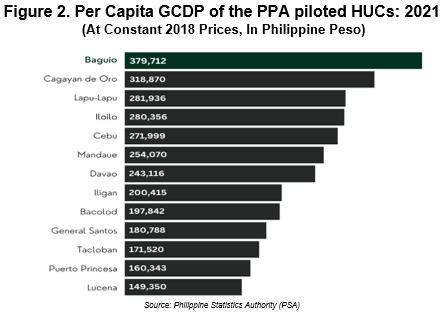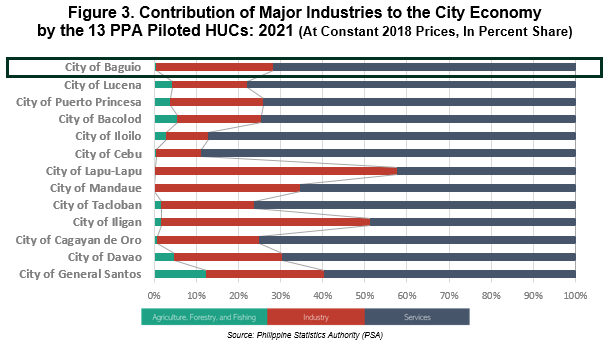


With 9.9 percent growth,
Baguio City ranks 1st among 13 PPA piloted HUCs
The economy of the City of Baguio rebounded from the COVID-19 pandemic and recorded a growth of 9.9 percent in 2021 making it the fastest-growing city economy among the 13 PPA piloted HUCs. It was closely followed by the City of Cagayan De Oro with growth of 9.6 percent.
In terms of total city economic output, City of Davao had the largest GCDP with 454.7 billion pesos. This was followed by City of Cebu and City of Cagayan de Oro with 266.0 billion pesos and 239.3 billion pesos, respectively. The City of Baguio had the fourth largest GCDP with 139.2 billion pesos.
It can be observed that four HUCs did not achieve a 9-digit economic output namely: City of Iligan, City of Puerto Princesa, City of Tacloban, and City of Lucena.
In addition to having an 8-digit GCDP, City of Puerto Princesa also posted the slowest growth among the 13 PPA piloted HUCs with 2.5 percent.

In terms of per capita output, with 379,712 pesos, the per capita GDP of Baguio was the highest among the 13 highly urbanized cities. In addition, Baguio City recorded a per capita GDP that was 122.8 percent higher than the 170,398 peso per capita GDP of the entire Cordillera Administrative Region.

As to distribution of major industries, 11 out of the 13 HUCs including the City of Baguio were predominantly Services-based. While the City of Lapu-Lapu and City of Iligan were the only cities that were Industry-based.
The City of Baguio ranked 10th as to its AFF with GVA of 869.3 million pesos, ranked 4th as to its Industry with GVA of 38.6 billion pesos, and ranked 5th as to its Services with GVA of 99.7 billion pesos.

As to contributors to city economy, 9 HUCs are Wholesale and Retail Trade-driven
and 4 HUCs, including Baguio City are Manufacturing-driven
The top three (3) HUCs that were Trade-driven were Davao City with 125.8 billion pesos, Cagayan De Oro City with 98.4 billion pesos, and Cebu City with 71.3 billion pesos. For Manufacturing-driven HUCs, Lapu-Lapu City ranked 1st with 66. 7 billion pesos, followed by Baguio City with 30.9 billion pesos.
As to least industry contributor, eleven (11) HUCs had Mining and Quarrying as their industry with lowest GVA This included Baguio City with Mining and Quarrying output of 644.0 thousand pesos. City of Mandaue had Agriculture, Forestry, and Fishing as its least industry contributor with GVA of 37.8 billion pesos, while City of Iligan had Other Services as its industry with lowest GVA with 355.7 thousand pesos.

With GCDP valuing at 139.2 billion pesos, Baguio City ranked fourth among the 13 PPA piloted HUCs in terms of economic production. In addition, Baguio City was the fastest-growing HUC economy with 9.9 percent growth, and reported the highest per capita GCDP with 379,712 pesos.
The City of Baguio reported a faster growth and higher per capita GDP than the region of Cordillera (with per capita GDP of 170,496 pesos and growth of 7.6 percent) and the country (with per capita GDP of 168,242 pesos and growth of 5.7 percent).
(SGD)
VILLAFE P. ALIBUYOG
Regional Director
________________________________________________
TECHNICAL NOTES
Gross Provincial/City Domestic Product (GPDP/GCDP)
- The aggregate of gross value added (GVA) of all resident producer units in a province/city.
- Measures the economic performance of the province/city from the perspective of the producers of goods and services. It covers the value of goods and services produced in the region during the reference period.
- GPDP/GCDP measures the relative contribution of the 16 highlighted industries under the Philippine Standard Industrial Classification (PSIC), namely:
- Agriculture, Forestry, and Fishing (AFF)
- Mining and Quarrying (MAQ)
- Manufacturing (MFG)
- Electricity, Steam, Water and Waste Management (ESWW)
- Construction (CNS)
- Wholesale and retail trade; repair of motor vehicles and motorcycles (TRD)
- Transportation and storage (TAS)
- Accommodation and food service activities (AFSA)
- Information and communication (IAC)
- Financial and insurance activities (FIA)
- Real estate and ownership dwellings (REOD)
- Professional, and business services (PBS)
- Public administration and defense; compulsory social activities (PAD)
- Education (EDUC)
- Human health and social work activities (HHSW)
- Other services (OS)
Constant prices
- way of measuring the real change in output. A year chosen as the base year. For any subsequent year, the output is measured using the price level of the base year. This excludes any nominal change in production and enables a comparison of the actual goods and services produced.
Growth Rate
- refers to the percentage change of a specific variable within a particular time.
Percent Distribution
- means the percentage obtained by dividing the aggregate value of the Share Consideration (determined by reference to the Closing Share Price) by the Aggregate Consideration Value.
Per Capita GDP
- a financial metric of the economic output per person and is calculated by dividing the GDP by its population.




